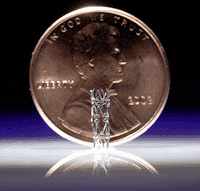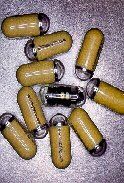 | |
| Todd Bennett - The
STATE The wire-mesh stent helps prevent strokes and heart attacks by keeping the arteries clear. This stent, made by Cordis, is coated with Heparin to prevent blood clots. | |
A device tiny enough to tuck into your shirt pocket could be the next medical marvel that saves your vision, your hearing or your life.
Bigger can be better in health care - as with MUSC's cavernous new MRI machine that weighs 12,114 pounds - but for many patients, it's little gadgets that make a big difference.
An implantable lens for cataract patients, who used to need thick eyeglasses after surgery, lets most people shed their specs. New gadgets for diabetics are unobtrusive and easy to use, and new implantable devices help weak hearts pump better. A capsule you swallow moves through the intestines taking pictures.
Here's a look at some of these small wonders.
STENTS HELP FIX CLOGGED ARTERIES
Every year, about a million Americans undergo angioplasty, in which arteries are opened up to improve blood flow from the heart. About 80 percent of these people leave the hospital with something new: tiny, wire-mesh cylinders in their blood vessels.
Stents are one of the modern miracles of cardiac care, an alternative to major surgery and an improvement over balloon angioplasties that merely clear tissue from arteries.
"We're able to prevent a lot more people from having to come back for second or even third procedures," said Christopher Nielsen, a cardiologist at the Medical University of South Carolina.
Stents prop arteries open, restoring blood flow and possibly preventing heart attacks. Arteries cleared by balloon angioplasty become clogged again by scar tissue about 40 percent of the time, but with stents, that scarring, or restenosis, occurs only about 20 percent of the time.
"Anytime you put a foreign body in there, people develop scar tissue; it's a natural reaction," Nielsen said. In some people, scar tissue multiplies rapidly, similar to the way cancer cells grow.
Stents coated with the drug Heparin reduce formation of blood clots, and the next crop of stents will be coated with chemotherapy drugs to stop the growth of scar tissue.
Federal approval of the newest stents might come as early as November, Nielsen said, and trials show they work extremely well. Stents range in cost from about $1,000 to $3,000.
At the Columbia Heart Clinic, interventional cardiologist Daniel Bouknight is testing stents to help prevent strokes. South Carolina leads the nation in stroke deaths, and having a mild stroke puts a person at high risk for suffering a more serious one.
Some patients are having stents placed in their carotid arteries, the main suppliers of blood to the brain. This is not yet approved by the Food and Drug Administration, and patients must be poor candidates for surgery.
Stent placement is "a lot less invasive" than surgery, Bouknight said; it is done through a puncture site in the leg while patients are awake. The goal is to prevent a brain-damaging stroke, a serious risk when the artery is clogged.
So far, the rate of scarring in the stents is low and comparable to that of surgery, he said.
For more information on the carotid artery stent trials, which are done at Providence Hospital, call the Columbia Heart Clinic at (803) 376-4100.
ON-THE-GO GLUCOSE TESTING
Don't try to slow down Deree Stobaugh.
She's a diabetic, but she fits procedures such as testing her blood sugar into an active life that includes motorcycle trips with her husband, Rick.
Proud owner of a new One-Touch Ultra blood glucose tester, she said it's half the size of the device she had used.
"This little gadget is just so easy for me to carry," said Stobaugh, 50, who lives in West Columbia.
It can test blood from her arm or leg instead of just fingertips, and takes just a trace. That makes it easier to do the blood tests she needs at least four times a day.
"It gives you your life back," said Val Summersett, a diabetes educator at Lexington Medical Center. "You want diabetes to fit into your lifestyle and not have it take so much time."
The One-Touch Ultra, by LifeScan, costs about $68.
PICTURES FROM A PILL

|
Doctors used to do exploratory surgery to find the source of intestinal bleeding when procedures such as colonoscopy couldn't solve the mystery.
Now, an option might be wireless capsule endoscopy. That's a big term for something performed by a device the size of a multivitamin, which photographs its way through the body.
"Our main goal is to prevent surgery by doing this test, and find something that can be treated with medication," said Karen Baxley, an endoscopy nurse at McLeod Regional Medical Center in Florence.
McLeod is the third hospital in the state to perform the procedure. (Roper Hospital and MUSC in Charleston were first and second.) The patient swallows the yellow capsule with a sip of water and wears a Walkman-size battery pack. For about eight hours, the capsule travels through the digestive tract.
"It's taking pictures constantly," Baxley said.
Information from the camera's fantastic voyage is downloaded into a computer and analyzed by a gastroenterologist. Problems that might show up include tumors, diverticulosis or colitis.
COST OF THE CAPSULE ENDOSCOPY PROCEDURE IS ABOUT $2,350.BRIGHT SOLUTION FOR CATARACTS
Art Baker of Blythewood knew he was getting cataracts, which make the eye's lens yellow sort of like pages of an old book. He had trouble driving at night, and some objects seemed to have halos around them.
But he didn't realize how impaired his vision was until after his cataract surgery, when the world suddenly looked bright and vivid again.
"Really and truly, my eyes are about like they were when I was a young man," said Baker, 72, a retired football coach and a consultant to the Gamecocks.
At the Columbia Eye Center, ophthalmologist Rick Milne removed the centers of the damaged lenses and surgically implanted Array lenses.
Baker had been using one set of glasses for reading and another set for activities such as tennis and quail hunting; now he doesn't need glasses at all.
The lens has concentric circles with varying powers to enhance distant, midrange and near vision, said Linda St. Louis, clinical supervisor at the Eye Center.
About 11‘percent to 15 percent of patients still need to wear some type of corrective lenses, she said.
The Array procedure costs about $2,500 per eye.
HELPING THE HEART DO ITS JOB
People with congestive heart failure suffer from extreme fatigue and shortness of breath, and heart transplants have been their only hope. But some are receiving a newly approved device instead.
A cardiac resynchronization (or ventricular pacing) device delivers an electrical impulse to the heart. It does more than a conventional pacemaker, which helps a heart that's beating too slowly, or a defibrillator, which steadies a heart that's beating too fast.
Besides regulating the rhythm, "it makes the heart squeeze better, so you get more out of every beat," said Columbia cardiologist Venk Gottipaty, who specializes in heart rhythm problems.
Gottipaty came to the South Carolina Heart Clinic a year ago from the University of Pittsburgh, a main center for heart transplants. It was involved in clinical trials for the new device, which the Food and Drug Administration approved about six months ago.
Many people needing heart transplants were removed from the waiting list when they received resynchronization devices instead, Gottipaty said.
"People who have had golf carts just to go and get their mail now are walking three miles a day," he said.
Ruby Woods of West Columbia isn't quite there yet. But after suffering from congestive heart failure for years, she said receiving one of the devices made her feel like a new person.
"The very next day I walked across the room and I wasn't gasping for air," said Woods, 62. "I was breathing easily."
She said her pain and her worries were relieved by her surgery Oct. 9:
"I feel like I have a new lease on life."
A Medtronic InSync cardiac resynchronization device like the one she received costs about $12,000, according to the manufacturer (not including hospital and surgery costs). The part that's implanted in the chest is about the size of two stacked silver dollars.
HE WHO HAS EARS, LET HIM HEAR
Rush Limbaugh hears "dittos" from callers again thanks to cochlear implants, which he needed after an autoimmune disorder left him profoundly deaf.
If you need these implants, it would help to be a multimillionaire radio talk show host or at least have good insurance. They cost about $30,000, 10 times as much as top-quality hearing aids.
But they can be a sound solution for nerve deafness, which also may result from an infection such as meningitis or a traumatic injury such as a skull fracture.
"The cochlear implant is the first device developed to replace one of our normal senses," said Dr. Paul Lambert, who leads the otolaryngology department at the Medical University of South Carolina.
High-tech tweaking has improved these implants during the past few years, he said. The microphone that picks up sound has been miniaturized and computerized to fit over the ear. Sounds are processed and sent to an implanted electrode that can send 30,000 pieces of information per second to surviving nerve fibers in the cochlea. Bits of information then are sent to the brain, which "hears" them as sounds.
"It's impossible to restore normal hearing; we can't replace what we're born with," Lambert said. The ear is one of the most complicated organs, with more than a million moving parts.
But with practice, adjustments and programming by an audiologist - which can add as much as $20,000 to the costs - people with implants can hear and understand conversation, including political chat on the phone.